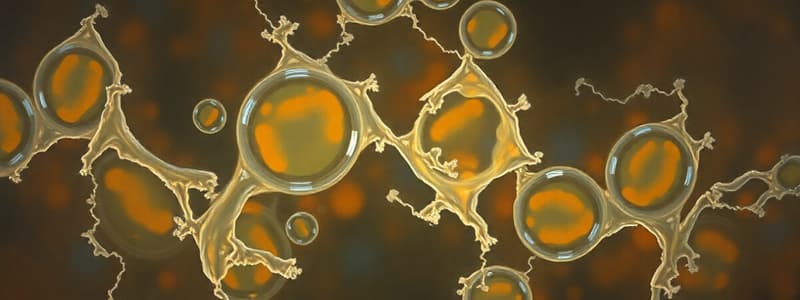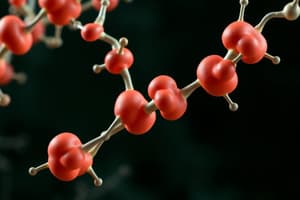Podcast
Questions and Answers
What is the final product synthesized by fatty acid synthase in the cytoplasm?
What is the final product synthesized by fatty acid synthase in the cytoplasm?
- Stearate (18:0)
- Oleate (18:1)
- Myristate (14:0)
- Palmitate (16:0) (correct)
Acetyl CoA is directly transported from the mitochondrial matrix into the cytoplasm for fatty acid synthesis.
Acetyl CoA is directly transported from the mitochondrial matrix into the cytoplasm for fatty acid synthesis.
False (B)
What enzyme carboxylates acetyl CoA to activate it for fatty acid synthesis?
What enzyme carboxylates acetyl CoA to activate it for fatty acid synthesis?
acetyl CoA carboxylase
The acyl carrier protein (ACP) contains a prosthetic group similar to _______.
The acyl carrier protein (ACP) contains a prosthetic group similar to _______.
Which enzyme condenses malonyl ACP and acetyl ACP to form acetoacetyl ACP?
Which enzyme condenses malonyl ACP and acetyl ACP to form acetoacetyl ACP?
The elongation of fatty acids beyond palmitate occurs in the cytoplasm.
The elongation of fatty acids beyond palmitate occurs in the cytoplasm.
What molecule provides the reducing power needed for fatty acid synthesis?
What molecule provides the reducing power needed for fatty acid synthesis?
AMP-activated protein kinase (AMPK) inhibits acetyl CoA carboxylase by adding a _______ group.
AMP-activated protein kinase (AMPK) inhibits acetyl CoA carboxylase by adding a _______ group.
Match the enzyme with its corresponding function:
Match the enzyme with its corresponding function:
Where does the synthesis of fatty acids primarily take place?
Where does the synthesis of fatty acids primarily take place?
Palmitate can be directly extended by fatty acid synthase to produce longer fatty acids.
Palmitate can be directly extended by fatty acid synthase to produce longer fatty acids.
What enzyme releases palmityl ACP to yield free palmitate?
What enzyme releases palmityl ACP to yield free palmitate?
Citrate acts as an _______ activator of acetyl CoA carboxylase, promoting its oligomerization.
Citrate acts as an _______ activator of acetyl CoA carboxylase, promoting its oligomerization.
Which of the following hormones inhibits acetyl CoA carboxylase via AMPK activation?
Which of the following hormones inhibits acetyl CoA carboxylase via AMPK activation?
Double bonds can be added to fatty acids beyond carbon 9 by enzymes in the endoplasmic reticulum.
Double bonds can be added to fatty acids beyond carbon 9 by enzymes in the endoplasmic reticulum.
What transports oxaloacetate from the cytoplasm back into the mitochondrial matrix?
What transports oxaloacetate from the cytoplasm back into the mitochondrial matrix?
Protein phosphatase 2A activates acetyl CoA carboxylase by removing _______ groups.
Protein phosphatase 2A activates acetyl CoA carboxylase by removing _______ groups.
Match the following enzymes with the reactions they catalyze in fatty acid synthesis:
Match the following enzymes with the reactions they catalyze in fatty acid synthesis:
Which of the following is used in fatty acid synthesis as the reducing agent?
Which of the following is used in fatty acid synthesis as the reducing agent?
Insulin activates AMPK to promote fatty acid synthesis.
Insulin activates AMPK to promote fatty acid synthesis.
Flashcards
Where does FA synthesis happens?
Where does FA synthesis happens?
Fatty acid synthesis occurs in the cytoplasm using the mega enzyme fatty acid synthase. The main product is palmitate (16:0).
What are the building blocks for FA synthesis?
What are the building blocks for FA synthesis?
Acetyl CoA and NADPH are used. Acetyl CoA provides the basic building blocks, and NADPH acts as the reducing agent.
How to activate Acetyl CoA?
How to activate Acetyl CoA?
Acetyl CoA is carboxylated by acetyl CoA carboxylase to produce malonyl CoA.
What is Acyl Carrier Protein (ACP)?
What is Acyl Carrier Protein (ACP)?
Signup and view all the flashcards
Malonyl ACP reactions?
Malonyl ACP reactions?
Signup and view all the flashcards
Function of ER membrane enzymes?
Function of ER membrane enzymes?
Signup and view all the flashcards
How does AMPK regulate FA?
How does AMPK regulate FA?
Signup and view all the flashcards
Role of protein phosphatase 2A?
Role of protein phosphatase 2A?
Signup and view all the flashcards
Citrate's role?
Citrate's role?
Signup and view all the flashcards
How glucagon, epinephrine, and insulin act?
How glucagon, epinephrine, and insulin act?
Signup and view all the flashcards
Study Notes
- Fatty acid synthesis occurs in the cytoplasm via the mega enzyme fatty acid synthase.
- The fatty acid synthase can only produce palmitate (16:0).
- Acetyl CoA serves as the basic building block in fatty acid synthesis.
- NADPH is the reducing agent.
- Acetyl CoA, produced in the mitochondrial matrix, needs to be transported to the cytoplasm.
- It is combined with oxaloacetate to form citrate, which is then transported to the cytoplasm.
- In the cytoplasm, citrate is converted back to acetyl CoA and oxaloacetate.
- Oxaloacetate is reduced to malate by malate dehydrogenase to transport it back into the mitochondrial matrix.
- Malate is converted to pyruvate by malic enzyme, reducing NADP+ to NADPH.
- Pyruvate is transported back into the matrix and converted to oxaloacetate by pyruvate carboxylase.
- Acetyl CoA carboxylase carboxylates acetyl CoA to produce malonyl CoA, activating it for fatty acid synthesis.
- Acyl carrier protein (ACP) switches the acyl carrier for both acetyl CoA and malonyl CoA.
- ACP has a prosthetic group similar to CoA.
- This switch is facilitated by malonyl-acetyl transacylase (MAT).
- Malonyl ACP is added to acetyl ACP, through a series of 4 reactions.
- Beta-ketoacyl synthase condenses malonyl ACP and acetyl ACP to form acetoacetyl ACP.
- Beta-ketoacyl reductase reduces acetoacetyl ACP to 3-hydroxybutyryl ACP, with NADPH as the reducing agent.
- 3-hydroxyacyl dehydratase converts 3-hydroxybutyryl ACP to crotonyl ACP (trans A2 enoyl ACP) via dehydration.
- Enoyl reductase reduces crotonyl ACP to butyryl ACP, with NADPH as the reducing agent.
- The resulting acyl ACP can be extended by adding additional malonyl ACP using the four reactions.
- After seven cycles with the four reactions, palmitoyl ACP is produced.
- Palmitoyl ACP is released from ACP by thioesterase.
- All the enzymes needed for fatty acid synthesis are part of a single polypeptide chain (fatty acid synthase), except acetyl CoA carboxylase.
- Palmitate is the only fatty acid that fatty acid synthase can make.
- Enzymes in the ER membrane can extend palmitate with additional malonyl units.
- Double bonds can be added in the ER membrane, but only at carbon 9 of the fatty acid.
Regulation of Fatty Acid Synthesis
- Fatty acid synthesis is regulated by acetyl CoA carboxylase.
- AMP-activated protein kinase (AMPK) is stimulated by AMP (low energy charge).
- AMPK phosphorylates and inhibits acetyl CoA carboxylase.
- Protein phosphatase 2A dephosphorylates and activates the carboxylase.
- Citrate acts as an allosteric activator to acetyl CoA carboxylase.
- Citrate induces oligomerization of the enzyme, enhancing its activity independently of its phosphorylation state.
- Glucagon and epinephrine activate AMPK
- Glucagon and epinephrine inhibit acetyl CoA carboxylase and fatty acid synthesis.
- Insulin promotes dephosphorylation and activation of the carboxylase, thus promoting fatty acid synthesis.
Studying That Suits You
Use AI to generate personalized quizzes and flashcards to suit your learning preferences.




